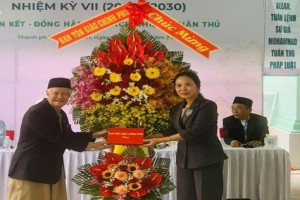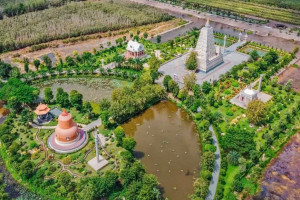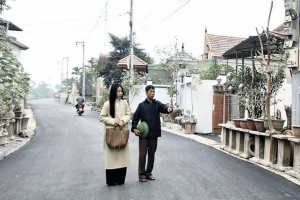
Craftsman Ly Let is the son of elderly Ly Nghet who is well-known for building pagodas throughout the southern cities and provinces. Succeeding his father, Ly Let has also become a famous pagoda builder. He has built and restored over 400 pagodas which bear the typical architectural and cultural characteristics of the Khmer ethnic people in Vietnam.
I met Ly Let for the first time at the “National Great Solidarity – Vietnam Cultural Heritage 2013” Week held in the Vietnam National Village for Ethnic Culture and Tourism in Dong Mo (Son Tay, Hanoi). He did not look like an architect or a researcher on Khmer culture in the south. With a dark complexion, grey-flecked hair and a muscular body he looked like a valiant bullfighter in Bay Nui. He said: “Doing the cultural conservation work one can not only do research with books and theories but must also go to the cultural areas to seek and find the most typical features of these areas.” It may be the reason why there is no place in the Southern region with so many rivers and canals without his footsteps.
Craftsman Ly Let was born in Phu My commune, My Tu District, Soc Trang province where over 90% of the population is Khmer ethnic people. As being the only son of the family, at the age of 6 or 7, he was taught how to carve decorative patterns on Khmer pagodas by his father. When his father died, the most precious asset left to him was a notebook with all types of decorative patterns and the know-how of building Khmer pagodas. Craftsman Ly Let confided: “Before my father died he told me that the pagoda was a cultural combination of the Khmer people. So the pagoda builder had to be honest and had to do the right things in accordance with the tradition, thereby preserving the soul of the nation.”
Although Ly Let has been involved in the construction and restoration of pagodas for a long time, his name became known after Doi pagoda in Soc Trang province was successfully restored in 2009. In August 2007, the main hall covering about 200m2 of the pagoda suddenly caught fire. The fire burned down its entire roof, wooden doors, columns, beams and dozens of Buddha statues and the furniture inside. Doi pagoda has been classified as a special national relic. It was built more than 400 years ago and had many Buddhist imprints of the Khmer people in the south. So the State decided to restore it as original and craftsman Ly Let was assigned to do this job.

The Khmer pagoda’s main hall bears Buddhist cultural characteristics of the Khmer ethnic people

Craftsman Ly Let explains to young people about decorative patterns and designs of the Khmer pagoda
Ly Let said that to restore the pagoda as original, in three consecutive years, from 2007 to 2009, he had to go to Khmer pagodas everywhere to study the decorative patterns and designs of typical culture and architecture of the Khmer people in the South so as to apply to the restoration of Doi pagoda. The most difficult work in the restoration of the pagoda was the restoration of the Sakyamuni Buddha statue made of sandstone which had been damaged by the fire. For the parts which were less damaged, he proposed to use the stone powder and glue for repairing, and for the large cracks he proposed to drill and use iron for fixing it. Ultimately, after three years, the restoration of the pagoda was successfully completed.
All Khmer people in Soc Trang recognize that the restored Doi pagoda was very similar to the original pagoda, from its decorative patterns outside to its interior. The restoration was so successful that News Agency AFP reported it as an event of historical hallmark of Vietnam in successfully restoring an ancient damaged architecture with craftsman Ly Let as the chief architect of this project.
In the construction and restoration of the pagodas of Khmer architectural style, the building of the Khmer pagoda in the Vietnam National Village for Ethnic Culture and Tourism took artisan Ly Let’s most concerted effort. He said: “I am particularly excited about this project because this is the first Khmer pagoda in the north. It is built not for display but it is a real pagoda with monks and serves as a place for religious practices of the Khmer people who are living and working in the capital city.” So, he has spent much effort and dedication on this special project to provide visitors and residents in the capital city of Hanoi with a typical cultural space of the Khmer people.

State President Truong Tan Sang visits the Khmer pagoda in the Vietnam National Village for Ethnic Culture and Tourism in Dong M.

The first Khmer pagoda in the North shows the talent of artisan Ly Let.

The first Khmer pagoda in the north becomes an interesting destination for the young to learn about architecture and culture of the Khmer people in the South.

Craftsman Ly Let feels excited when the first Khmer pagoda in the North has a monk appointed as its abbot and becomes a place for religious practices of the Khmer people.
It is reported that in the near future, artisan Ly Let will go to Cambodia to restore damaged pagodas at the invitation of the host country. For him, to work and share the knowledge of the Khmer culture is not only his passion but also his gratitude to the roots of the national culture.
BT (st)




